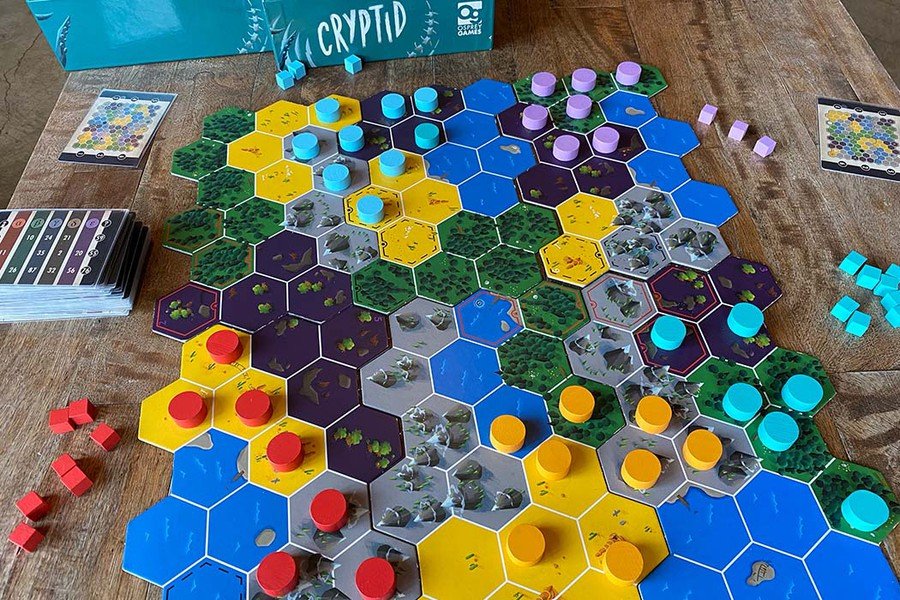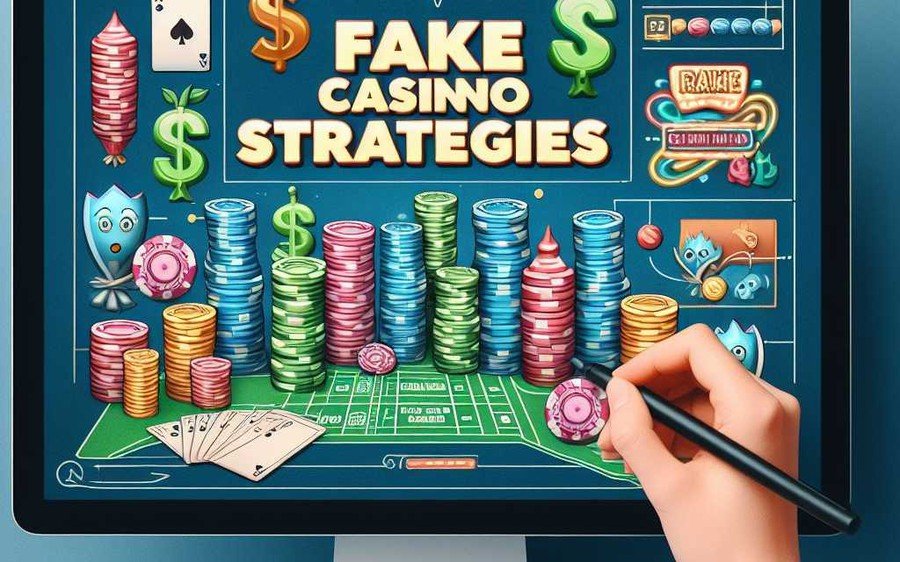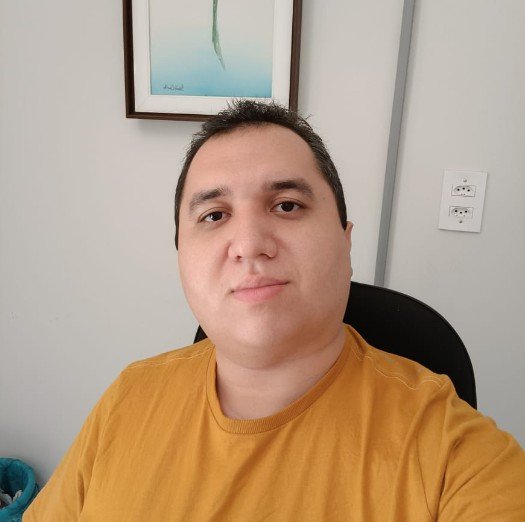Origin of the Cryptid Board Game
The board game Cryptid was created by Hal Duncan and Ruth Veevers, and was released in 2018 by Osprey Games. It is a deduction game that hunts down monsters in a "scientific research" setting. In it, each player is a researcher that studies mythological creatures, which means, they are cryptozoologists.
Game Mechanics
Cryptid is a board game that mixes elements of deduction, strategy, and research. In this game, we have 6 tiles, each made of 16 hexagonal spaces (desert, forest, water, mountain, and swamp). In some places, we may also find an "animal" territory, where, if a hexagon touches an animal, the same will have a subtle outline. If the outline is red, it's cougar territory; if it is a black outline, it's bear territory.
Ad
Besides tiles, we have player tokens, which may be of two types: cubes and wooden cylinders, each of the color chosen by the player. These tokens are easily translated as mechanics: the cube means "no", whereas the cylinders mean "yes". It's that simple.
We still have 5 books, each with 98 random clues on where the cryptid is, 54 cards indicating which books and clues will be used by players, besides the way the tiles must be placed. They've also included 4 shack pieces and 4 standing stones. You'll use all of these pieces to set up the match. Here are the main mechanics in the game:
Logic and Deduction
Players will use information provided by cards and clues to deduce the correct location of the cryptid on the board. At the beginning of the match, a player will draw a card that will indicate which book and clue each player must use.
Modular Board
This game's board is made of modular pieces, which means you can set up the game in a wide variety of ways. This makes the entire game more dynamic and lets you play it over and over again.
Geographical Clues
Each player gets a geographical clue that indicates a specific trait of the location of the cryptid. These clues aren't shared with other players because, like any good researcher, each player must look for the cryptid alone.
Eliminating Possibilities
Based on the information they were given, players eliminate possible locations on the board, and try to close in on the location of the cryptid. However, this is why the game is hard: as each player only has their own clues, each must figure out the other players' clues based on their "yes" or "no" plays.
To Ask or Research?
The cube and cylinder pieces play a crucial part in this part of the game. Each player can, on their turn, either ask or research one hexagon on the vast board.
Asking is when a researcher turns to another player and asks them if, according to their clue, the monster might be in that place. If they do so, the person who was asked must answer honestly with either "yes" or "no" (represented by cylinders or cubes). If the answer is negative, the researcher who asked has to, by rule, place a cube on some place on the board, according to their own clue.
Researching happens when a player is convinced they know exactly where the monster is. In this case, they'll put a cylinder on where they want to research, and, clockwise, other players must confirm or deny the accusation according to their clues. If a researcher denies the accusation, the other players don't need to answer the question anymore, and the researching player must, in the same way as they would if they were just asking, place a cube in some place their clue doesn't point to.
End of the Game
A match of Cryptid tends to last 50 minutes if it's the first time you're playing because new players need to adapt and get familiar with figuring out what each clue means. As you play more matches, a match tends to last a bit less. I've had initial matches that took a bit over an hour, but there were others that lasted only 20 minutes.
Ad
The end of the game and the title of best cryptozoologist are defined when one of the researches actually researches, and all other players answer "yes" when they're asked about the location that was researched. This determines that player is the best, most famous researcher in the world because they found a cryptid.
A good tip both for new players and veterans is to play slow. In the first matches, my friends and I played fast, without really thinking our decisions through, which made the game more confusing and senseless. This game demands patience. I strongly recommend you pick a researcher, try to understand where they have confirmed or ruled out the monster could be. If you do this with all other players, you'll maximize your chances of figuring out the other clues and finding the exact location of the cryptid.

Variations
Unlike other board games, this one comes with a game variation that, in theory, is quite simple. To make the game a bit harder, the designers decided to introduce negative clues. In general, the game's clues include statements like: "The monster is up to 3 hexagons away from a swamp" or "The monster is in a forest or desert". When the clues are like this, the game flows more easily. However, in the "harder" game mode, these clues become negative, like: "The monster isn't 2 hexagons away from water" or "The monster isn't in a forest or swamp". It might seem simple at first, but throughout the game these clues become more confusing because our minds are more used to positive statements than negative ones.
The rule book makes it clear that this harder game mode must be played only when all players are used to the way clues work and also know how to figure out what their opponents' clues mean.
The game was meant to be played by 3 to 5 people, but, sometimes, there are couples who want to play together. The game's community has created a solution for this. In this case, the game is set up to be played with 4 players, which means there will be 4 clues. Each player gets 2 clues, playing as if they were 2 researchers and each one using different colors. Even though the way you play this mode is simple, players must pay attention to their separate clues, considering each one will be playing 2 researchers.

Cryptid's Teaching Moments
As a board game, Cryptid can be used to learn several concepts. Here are some ways you can use this game to learn something:
Logical Thinking
Cryptid makes you use logic to figure out where the cryptid is, as players will have to rule out the possible places it can be. This can force you to work on your logical thinking and problem-solving skills.
Cooperation and Communication
Ad
Players need to work together and communicate to solve the mystery of where the cryptid is. It is important to stress that you can't say what your clues are directly; they must be "solved" by other players through "yes" or "no" answers.
This dynamic not only makes you work together with other players, but also improves your communication skills, as you have to relay information as directly as you can. This also improves your social skills.
Strategic Thinking
As you need to plan your moves on the board strategically, this game will improve your strategic thinking. Players have to consider, cautiously, how their actions will affect the game so they can boost their chances of finding the cryptid.
Geography and Location
Cryptid features geographical elements because players need to understand the clues that reference the board's topography. This might be a fun way to introduce or reinforce geographical concepts.
Decision-Making
Players will have to make decisions constantly, as they'll have to rule out where the cryptid might be. This improves your decision-making skills because each player will have to reflect on their options and choose the best approach.
Research Abilities
This game relies on looking for information to solve a mystery. This can be a transferable skill you can use when you're researching other, broader subjects as well.
Problem-Based Learning
Cryptid is essentially a game that focuses on solving one main mystery: finding the cryptid. This type of problem-based learning can be efficient to develop your critical thinking.
Risk-Reward Analysis
Players will face the dilemma of solving the mystery too early (and risk being taxed) or waiting too long (and risk not winning the game). This introduces the concept of analyzing the relationship between risk and reward.
Developing Patience
This game has a time limit, which encourages players to make efficient decisions under a specific time frame. This can help players develop patience and the ability to deal with time pressure. Introducing games such as Cryptid in a learning environment can be an exciting and efficient way to promote various abilities.
Popularity
When it was released, back in 2018, Cryptid was praised for its innovative deduction approach, strategic playability, and high replayability because of its modular board. Critics and players alike highlighted the game's tactical depth and its exciting challenge - finding the cryptid.
Cryptid's success can also be attributed to its appeal to different player profiles, as it is interesting both to casual players and board game experts, who are more into the strategy of board games. The quality of its design, artwork, and unique mechanics were the main factors that helped boost its initial popularity.
Final Words
This board game stands out among all other games we covered. It has a simple mechanic, but it requires its players to pay attention to end the game, considering if a player can't understand their clue, the game won't end and all deductions will be, certainly, wrong.
Ad
When it comes to learning, Cryptid offers us a wide array of abilities that you can teach, learn, or improve, and all of them can be applied to your day. It is a simple, easy game to play with people that aren't afraid to put their neurons to work to find out where our cryptid friend is.
See you next time!









— Comments0
Be the first to comment